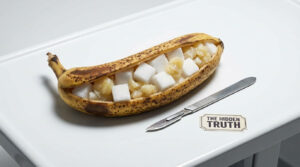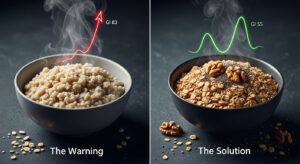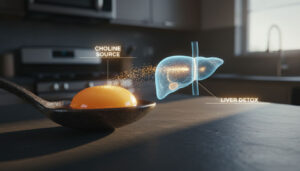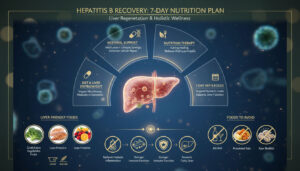Walking down the snack aisle after a diagnosis of Non-Alcoholic Fatty Liver Disease (NAFLD) or Metabolic Dysfunction-Associated Steatotic Liver Disease (MASLD) feels like navigating a minefield. You pick up a bag, read the label, sigh, and put it back. You just want something crunchy. You just want something that feels normal. The restrictive nature of liver-conscious dieting often leads to frustration and eventually the inevitable question: is popcorn good for fatty liver, or is it another joy you have to give up?
Table of Contents
The short answer is yes, popcorn is good for fatty liver, but only if you follow specific rules. Plain, air-popped popcorn is a high-fiber whole grain that aids in weight management and insulin sensitivity. It contains ferulic acid, a polyphenol that supports liver health. However, popcorn becomes a significant health risk when it is drenched in butter, loaded with salt, or prepared in microwave bags lined with toxic chemicals like PFAS. The difference between a liver friendly snack and a health hazard lies entirely in how you prepare it.
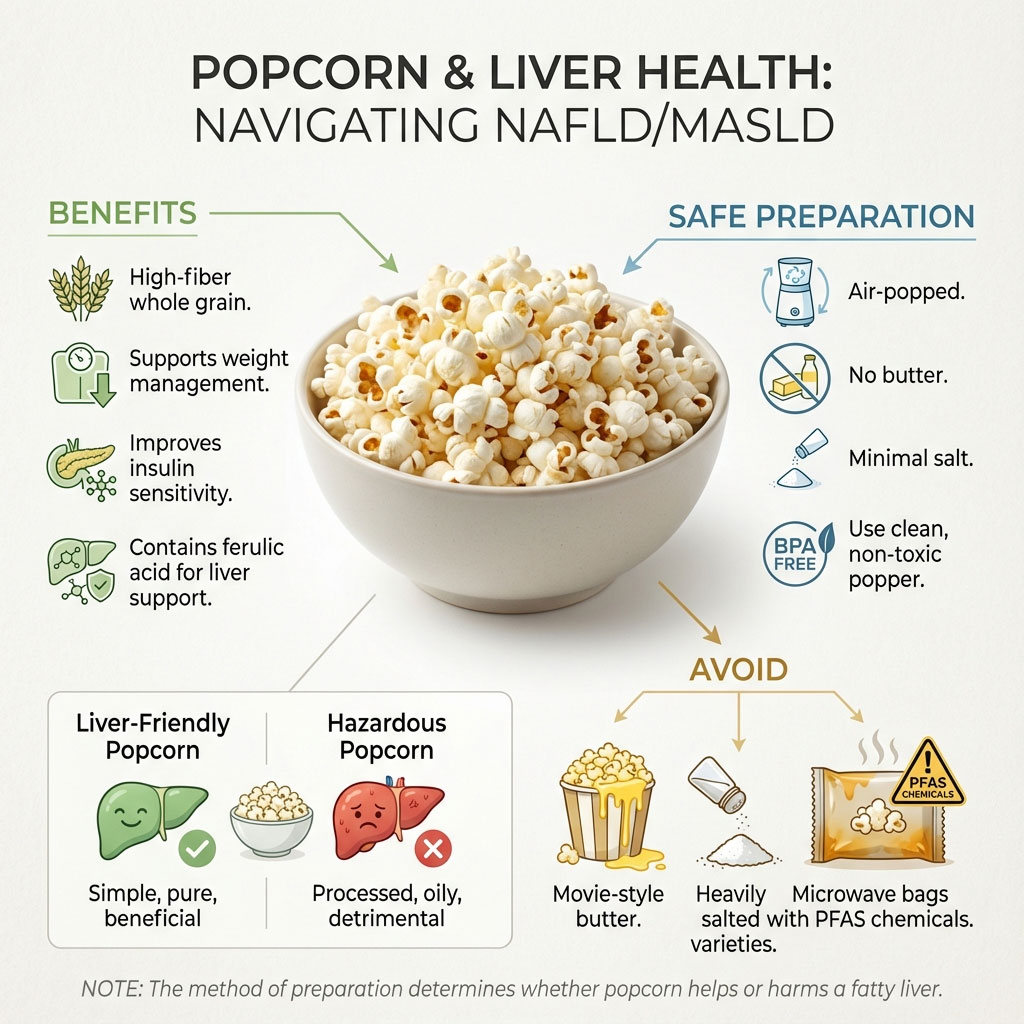
This comprehensive guide will walk you through the science of whole grains, the hidden chemical risks in commercial products, and the exact brands and recipes you need to enjoy this snack safely while healing your liver.
The Popcorn and Fatty Liver Connection
To understand the relationship between popcorn fatty liver risks and benefits, we first have to look at what the liver is up against. The condition formerly known as NAFLD, now increasingly referred to as MASLD diet management, is primarily driven by insulin resistance and metabolic dysfunction.
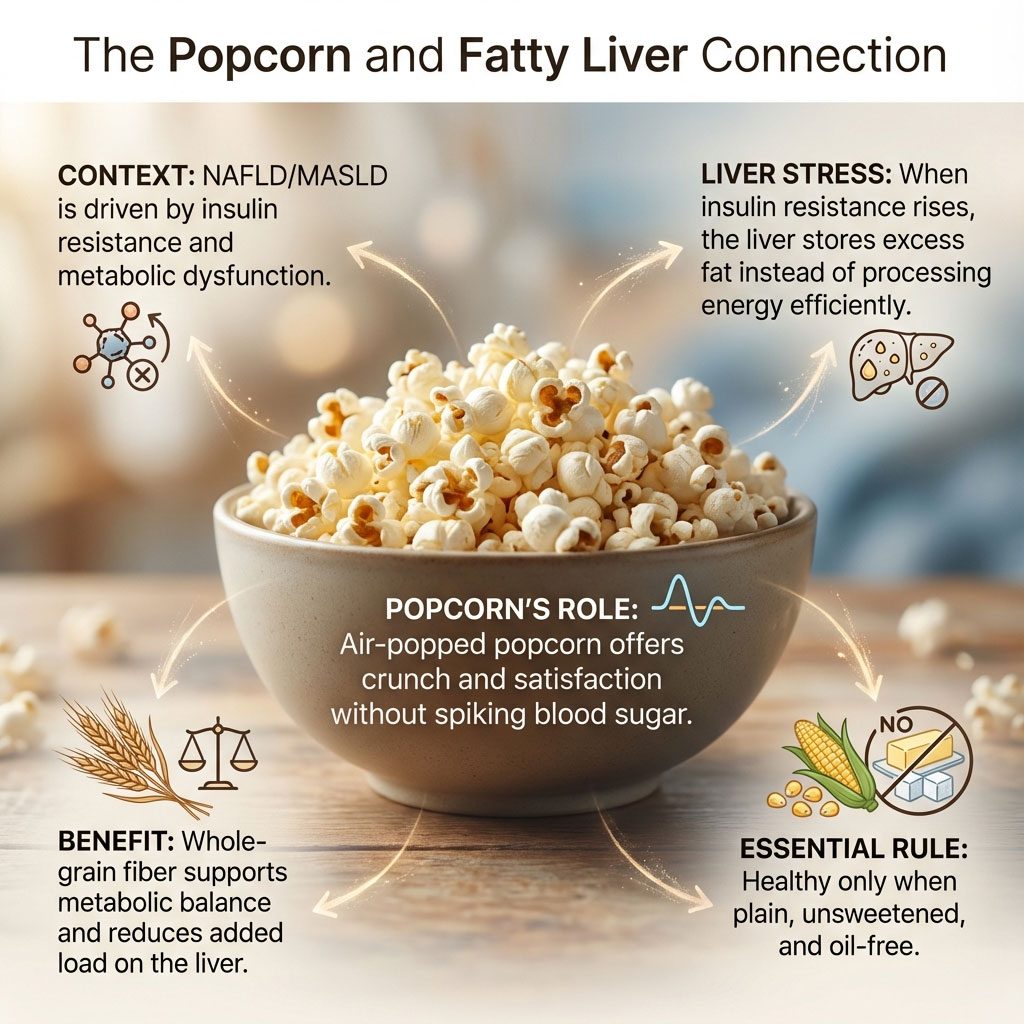
When your body becomes resistant to insulin, your liver stops processing energy efficiently and starts storing excess fat. The goal of any popcorn NAFLD snack is to provide satisfaction without spiking blood sugar or adding a toxic load to an already stressed organ. This balance is difficult to achieve, but popcorn serves as a unique bridge between comfort food and health food.
Why Whole Grains Are Critical for NAFLD and MASLD
Many patients assume they must cut all carbohydrates to heal their liver. This is a common misconception that often leads to diet failure. You need to cut refined carbohydrates like white bread, pasta, and sugar, but whole grain snacks for fatty liver are actually beneficial and necessary for long-term recovery.

Popcorn is 100% unprocessed whole grain corn. Unlike “corn puffs” or chips which are highly processed paste pressed into shapes, a kernel of popcorn contains the germ, the bran, and the endosperm. These three components work together to provide a complete nutritional package. The bran provides the fiber, the germ provides the healthy fats and antioxidants, and the endosperm provides the energy.
The Fiber Factor: How It Protects the Liver
Air popped popcorn benefits the liver primarily through its impressive fiber content. A standard 3-cup serving of air-popped corn delivers roughly 3.5 grams of dietary fiber. While this number might seem modest, it is significant when you consider the calorie-to-fiber ratio.
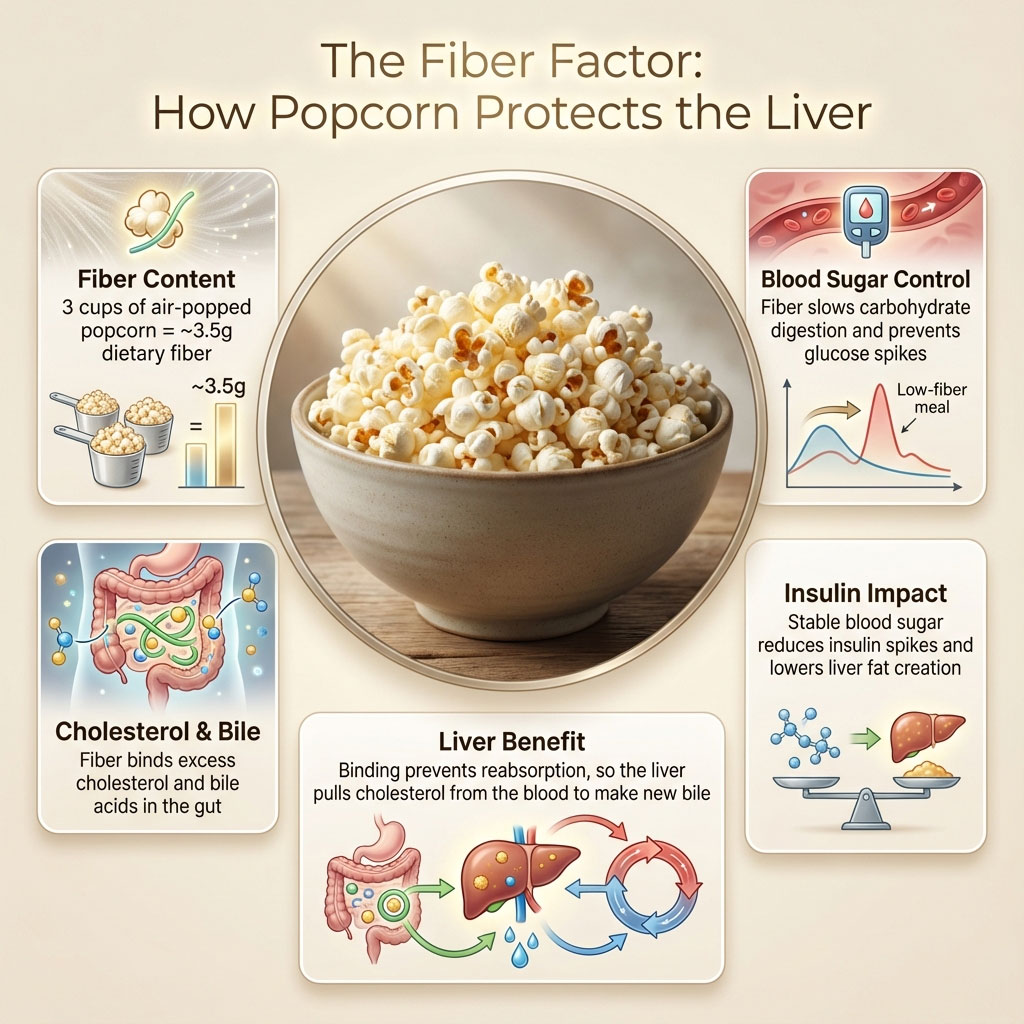
Fiber is the liver’s best friend for several physiological reasons. First, it acts like a sponge in your digestive system. Soluble fiber binds to excess cholesterol and bile acids in the gut, preventing them from being reabsorbed into the bloodstream. This process forces the liver to pull cholesterol from the blood to create new bile, effectively lowering overall cholesterol levels and reducing the burden on the liver.
For patients dealing with Metabolic Syndrome, fiber also plays a crucial role in glycemic control. It slows down the digestion of carbohydrates, which prevents rapid spikes in blood glucose. Since insulin spikes trigger the liver to store fat via a process called de novo lipogenesis, keeping blood sugar stable is the most effective way to manage popcorn and NAFLD dietary integration. By choosing a high-fiber snack, you are essentially dampening the insulin response and protecting your liver from storage signals.
The Satiety Index and Volume Eating
One of the hardest parts of a liver diet is feeling hungry. Restricting calories often leads to a rise in ghrelin, the hunger hormone. This is where popcorn fatty liver benefits shine. Popcorn allows for a strategy known as “volume eating.”
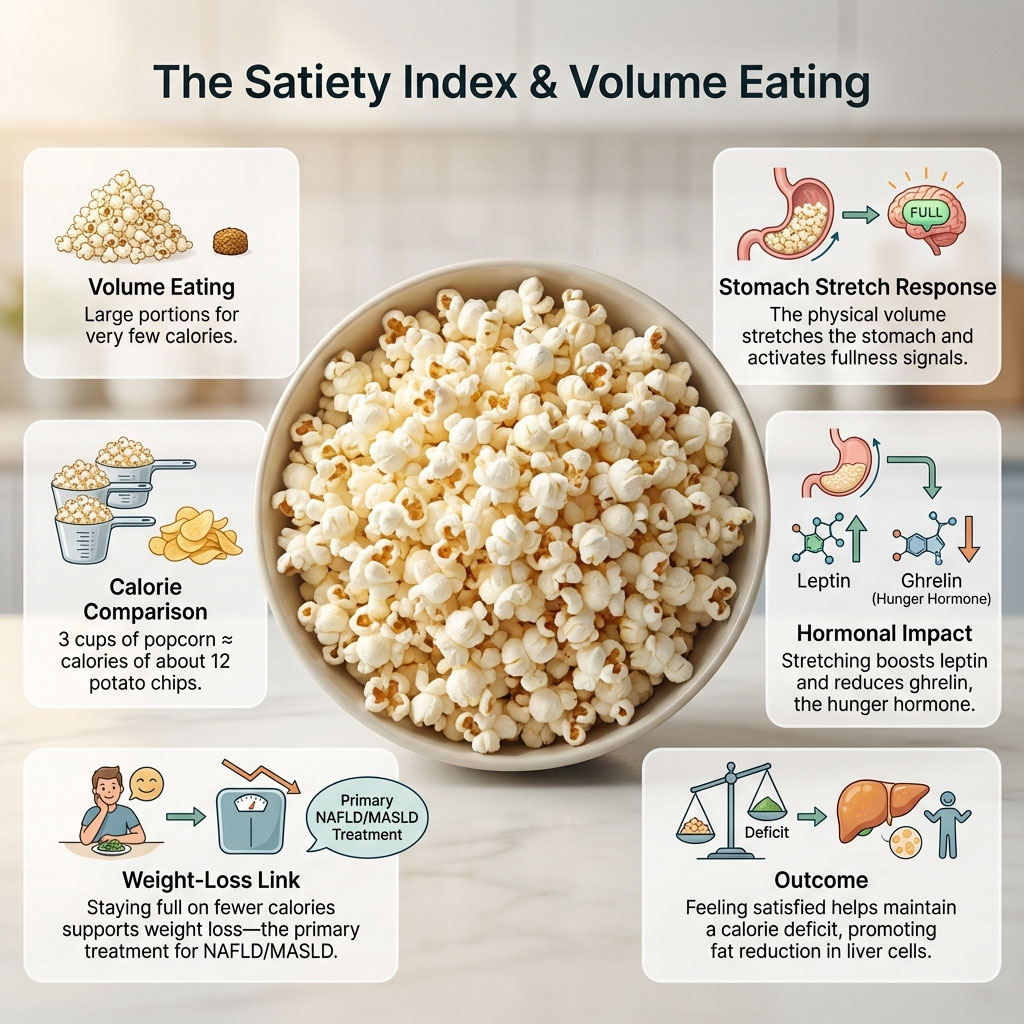
You can eat three full cups of popcorn for the same caloric impact as a dozen potato chips. This physical volume fills the stomach and stretches the gastric lining. This stretching triggers satiety hormones like leptin that signal your brain that you are full. Weight loss is the primary treatment for fatty liver disease, and finding snacks that keep you full for fewer calories are essential tools for recovery. If you can feel satisfied while maintaining a caloric deficit, you are far more likely to succeed in reversing the fat accumulation in your liver cells.
The Hidden Hero: Polyphenols and Ferulic Acid
Most people think of dark berries, tea, or leafy greens when they hear the word “antioxidants.” However, corn is a surprisingly potent source of a specific type of antioxidant called polyphenols. In fact, due to the low water content of popcorn, the concentration of these antioxidants is quite high compared to some watery fruits.
Understanding Ferulic Acid
Research, including landmark findings presented by the University of Scranton and published in antioxidant-focused journals, indicates that corn is particularly rich in ferulic acid. This is a powerful plant compound that has been studied for its potential to improve lipid metabolism and reduce inflammation.

Liver friendly snacks need to do more than just “not hurt” you. They should actively help the healing process. Ferulic acid has been shown to reduce oxidative stress within the body. Oxidative stress occurs when there is an imbalance between free radicals and antioxidants, a state that turns simple fatty liver (steatosis) into inflamed fatty liver (NASH or MASH).
By choosing whole grain snacks for fatty liver like popcorn, you are ingesting compounds that may help protect liver cells from fibrosis, which is the scarring of liver tissue. It is important to note that these antioxidants are found primarily in the hull of the kernel. This provides another reason why whole corn is superior to processed corn chips where the hull has been removed during the manufacturing process.
The Dangers: When Popcorn Becomes a “Sodium Trap” & Toxic Risk
If popcorn is so healthy, why do doctors often warn liver patients against it? The issue is not the corn itself. The issue is the vessel and the preparation. Microwave popcorn danger is a serious concern for liver health, involving chemical toxicity that many consumers are unaware of.

The Chemical Threat: Why Microwave Popcorn is Bad for Your Liver
Asking is popcorn good for fatty liver becomes a hard “no” if you are eating it from a microwave bag. The convenience of these bags comes at a steep physiological price.
The PFOA and PFAS Connection
For years, the lining of microwave popcorn bags contained Perfluorooctanoic Acid (PFOA), a toxic chemical linked to liver disease and cancer. While regulatory bodies like the FDA have restricted PFOA in food packaging, manufacturers have largely replaced it with “short-chain” PFAS (per- and polyfluoroalkyl substances) variants.

These replacement chemicals are structurally similar to their banned predecessors. Emerging environmental health research suggests that these short-chain PFAS can still accumulate in the body and may pose similar risks to liver toxicity and metabolic disruption. For someone already managing popcorn fatty liver concerns, introducing these persistent chemicals is counterproductive. It adds a chemical burden to an organ that is already struggling to perform its basic metabolic duties.
Diacetyl and Inflammation
That distinct, overwhelming fake butter smell is often caused by a chemical called diacetyl. While known for causing severe lung issues (often called “popcorn lung” in factory workers), ingested artificial flavorings are processed by the liver.
Chemical additives can increase inflammatory markers throughout the body. Systemic inflammation is a driver of liver disease progression. When you are looking for snacks for fatty liver disease, the ingredient list should be short and understandable. If it includes “artificial flavors” or chemical names you cannot pronounce, it is adding stress to your liver.
Trans Fats and Hydrogenated Oils
Check the label of generic microwave popcorn. You will often see “partially hydrogenated soybean oil” or “palm oil” listed among the top ingredients. These are inflammatory fats.
Omega-6 fatty acids, found in abundance in cheap vegetable oils, can promote inflammation when not balanced by Omega-3s. Most Americans already consume far too many Omega-6s. Liver friendly snacks must avoid trans fats entirely, as trans fats are directly linked to liver inflammation, insulin resistance, and an increase in visceral fat storage.
The Sodium-Ascites Connection
Sodium is the silent killer for liver patients. Low sodium snacks for fatty liver are not just a preference for blood pressure management. They are a medical necessity for liver function.
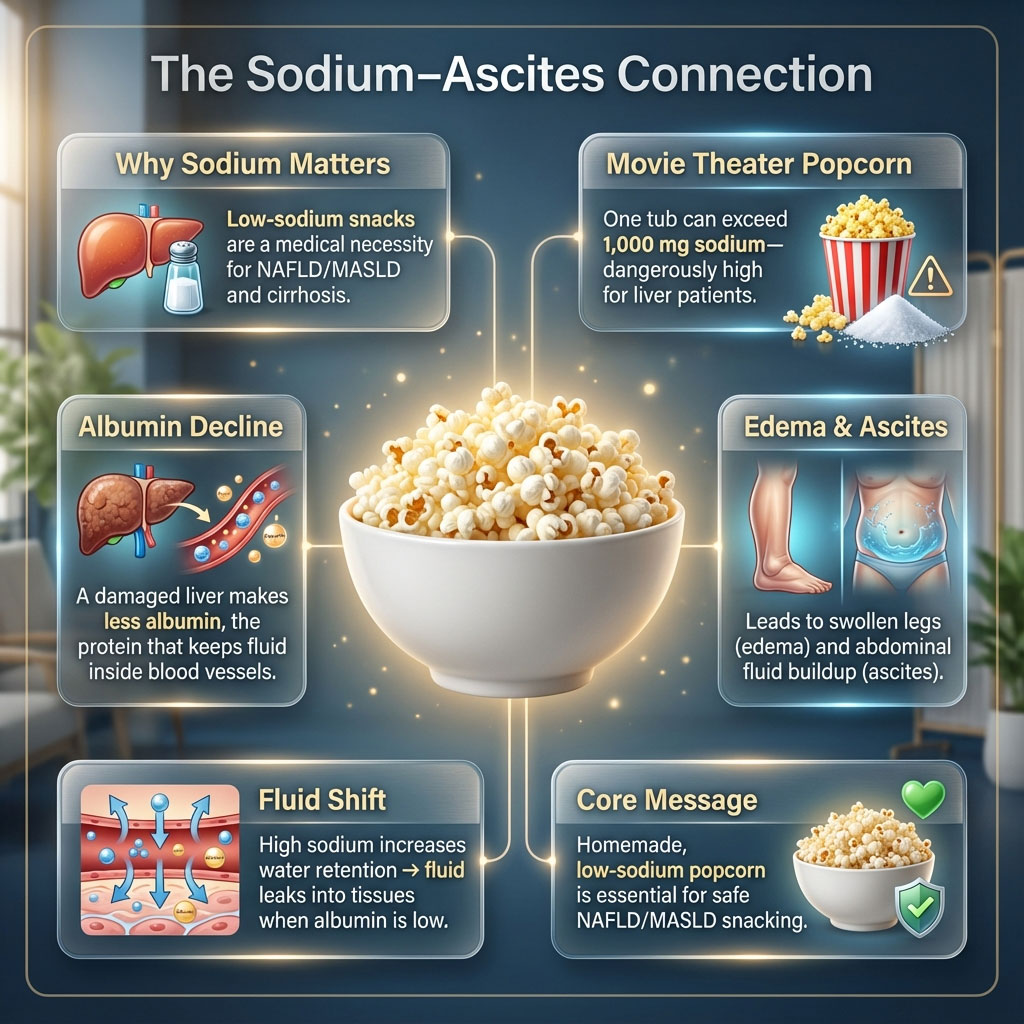
The Risk of Edema and Ascites
In the early stages of fatty liver, salt raises blood pressure, which puts strain on the cardiovascular system. However, in advanced stages (fibrosis or cirrhosis), the risk becomes much more immediate. The liver loses its ability to make albumin, a protein that keeps fluid inside your blood vessels.
When you consume high levels of sodium, specifically from movie theater popcorn fatty liver scenarios, the change in osmotic pressure causes your body to hold onto water aggressively. Because albumin levels are low, this fluid leaks out of the blood vessels and into the tissues. It causes swelling in the legs (edema) or dangerous fluid buildup in the abdomen (ascites).
A single tub of movie theater popcorn can contain over 1,000 mg of sodium. That is nearly half the daily limit for a healthy person and nearly the entire daily limit for a liver patient on a salt-restricted diet. This is why popcorn NAFLD snack choices must be homemade or carefully sourced to control the salt content rigorously.
Comparative Analysis: Popcorn vs. Other Snacks
To truly understand is popcorn good for fatty liver, we need to compare it to the alternatives. Many patients switch from chips to “veggie straws” thinking they are healthier, only to find they are just potato starch with food coloring. To make an informed decision, we must look at the caloric density, fat quality, and processing levels of common snacks.
Popcorn vs. Potato Chips and Crackers
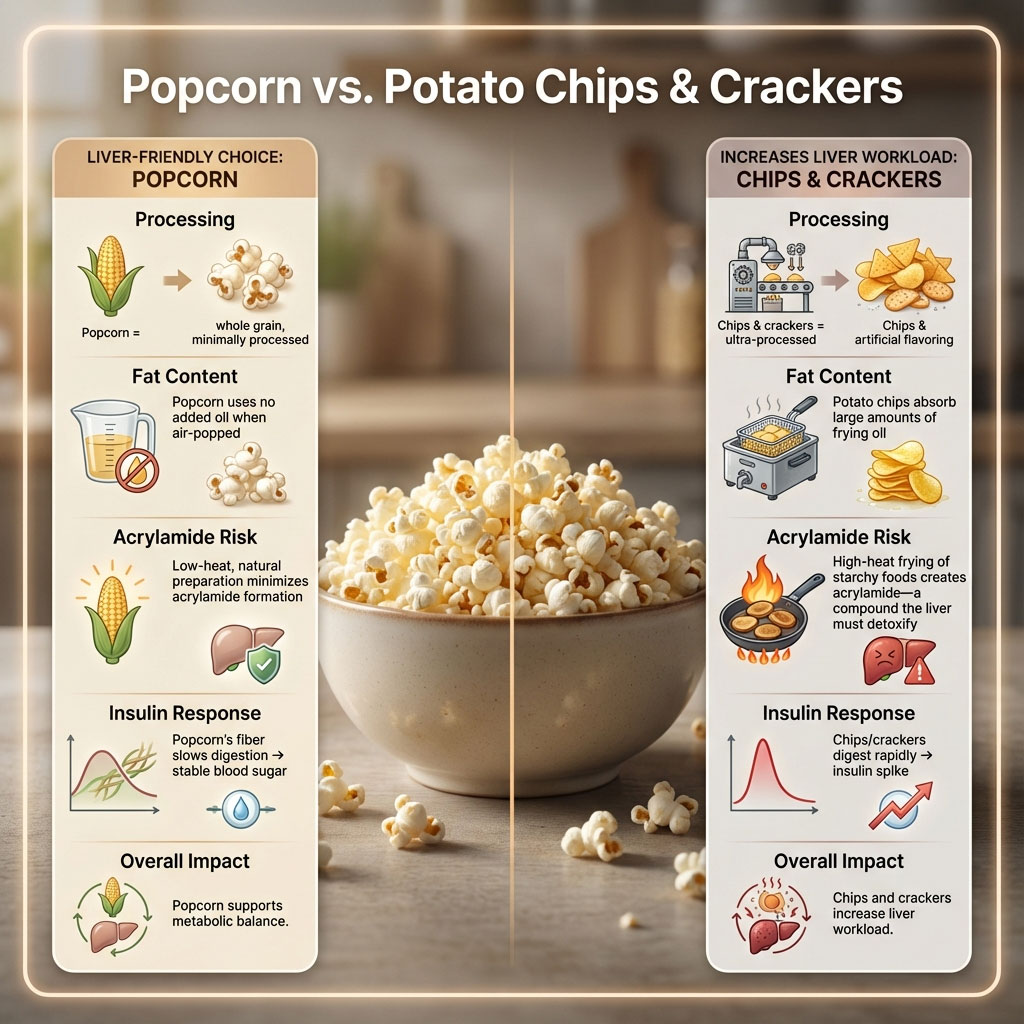
When we look at popcorn vs potato chips for liver health, the difference in fat content and processing is massive. Potato chips are sliced thin and deep-fried. This means they absorb a massive amount of oil. Furthermore, frying starchy foods at high temperatures creates acrylamide, a potential carcinogen that the liver must process.
Ultra-processed foods are rapidly digested. This spikes insulin almost immediately. Popcorn digests slowly due to the fiber and structure of the kernel. Here is a breakdown of how popcorn stacks up against common snack aisle competitors.
| Snack Type (1oz Serving) | Calories (Approx) | Saturated Fat | Sodium (Avg) | Verdict |
| Air-Popped Popcorn | 31 | 0.1g | 1mg | ✅ Safe |
| Microwave Popcorn (Butter) | 140 | 2-3g | 250-300mg | ❌ Avoid |
| Potato Chips (Classic) | 155 | 1.5g | 170mg | ❌ Avoid |
| Tortilla Chips | 140 | 1g | 150mg | ⚠️ Caution |
| Pretzels | 110 | 0g | 350mg+ | ⚠️ Caution |
| Unsalted Walnuts | 185 | 1.7g | 0mg | ✅ Safe |
Nutritional Breakdown of Common Snacks. While walnuts are higher in calories, they contain healthy fats. Popcorn wins on volume and low calorie density.
As the table demonstrates, air popped popcorn benefits include a massive reduction in sodium and saturated fat compared to chips. You can eat a larger quantity, which helps with the psychological aspect of dieting. Feeling deprived is the enemy of consistency. Being able to eat a large bowl of something crunchy without ruining your macros is a powerful psychological tool.
The Safe Shopping Guide: Best Brands for Fatty Liver (USA)
If you live in the USA, you have access to several excellent brands that cater to health-conscious consumers. You do not always have to pop it yourself to be safe, though homemade is always the gold standard. When looking for low sodium snacks for fatty liver, you need to read the label with a critical eye.
How to Read a Popcorn Label for Liver Health
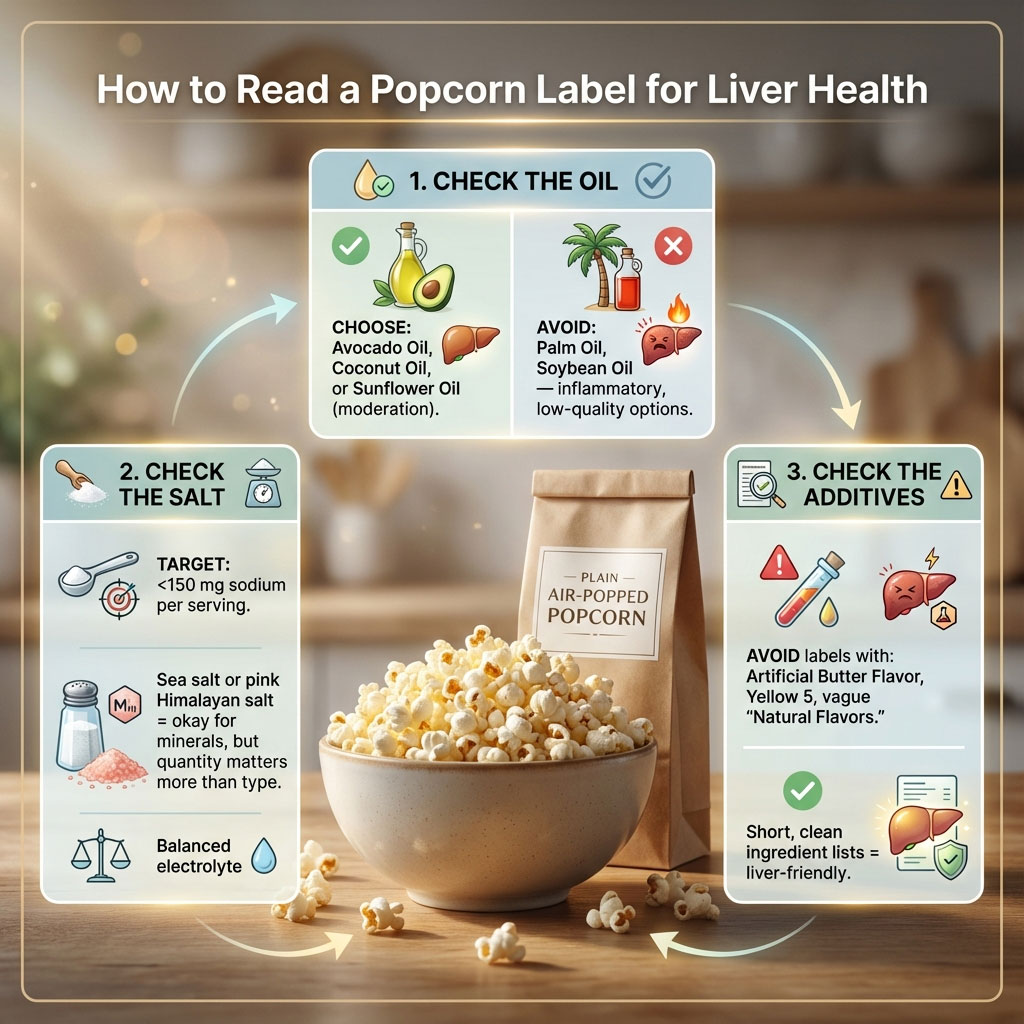
Before you buy, flip the bag over and look for these red flags and green lights.
- Check the Oil: You want Avocado Oil, Coconut Oil, or Sunflower Oil (in moderation). Avoid Palm Oil and Soybean Oil, as these are cheaper, inflammatory options often used in lower-quality products.
- Check the Salt: Look for less than 150mg of sodium per serving. “Sea Salt” or “Himalayan Pink Salt” is preferred as they contain trace minerals, but sodium is still sodium, so the quantity matters most.
- Check the Additives: If it says “Artificial Butter Flavor,” “Yellow 5,” or “Natural Flavors” without specifying what they are, put it back.
Top Recommended Brands
LesserEvil (The Cleanest Option)
LesserEvil is widely considered the best popcorn brand for fatty liver disease management commercially available. They use organic coconut oil, avocado oil, or organic ghee. Their “Himalayan Pink Salt” variety is low in sodium and avoids inflammatory vegetable oils. This fits perfectly into a MASLD diet because coconut oil provides Medium Chain Triglycerides (MCTs) which are processed differently than other fats.
SkinnyPop (The Convenient Choice)
Is Skinny Pop good for fatty liver? Yes. The “Original” bag contains just three ingredients: Popcorn, Sunflower Oil, and Salt. While sunflower oil is higher in Omega-6s than avocado oil, the simplicity of the ingredients makes it a safe popcorn NAFLD snack in moderation. There are no hidden chemicals or preservatives.
Quinn Snacks (The Chemical-Free Bag)
If you must use a microwave for convenience, Quinn Snacks is the solution. They use “Pure Pop” paper bags. These bags do not have chemical linings, plastics, or susceptors (the metal patch found in standard bags). You add the oil and spice packet after popping. This eliminates the microwave popcorn danger associated with PFOA while still offering a warm, fresh snack.
365 Organic (Whole Foods Market)
The 365 brand offers an air-popped variety with reduced sodium. It is cost-effective and strictly organic. Choosing organic is wise for corn products because conventional corn is one of the most genetically modified crops and is often heavily treated with pesticides like glyphosate, which adds to the liver’s toxin load.
Practical Strategies: Preparation and Recipes
The best way to ensure your snack is a liver friendly snack is to make it in your own kitchen. This gives you total control over the sodium and fat content. It transforms a processed food into a whole food.
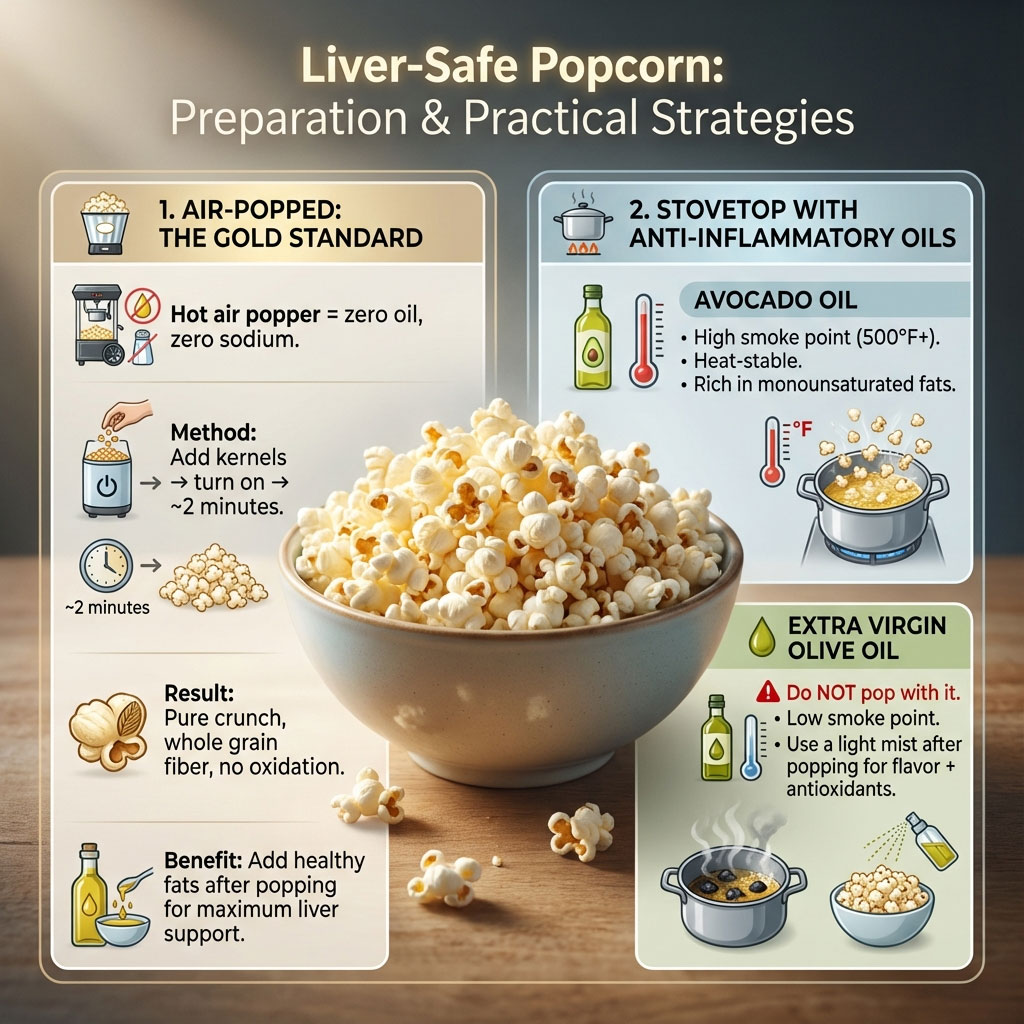
The Gold Standard: Air-Popped Preparation
Investing in a hot air popper is a smart move for anyone with liver disease. These machines are inexpensive and use circulating hot air to pop the kernels without any oil.
- Method: Pour kernels in. Turn it on. Wait two minutes.
- Result: Zero fat. Zero sodium. Pure crunch.
- Liver Benefit: You are eating pure fiber and carbohydrates. You can add your own healthy fat afterwards, ensuring the oil is never overheated or oxidized.
Stovetop Method with Anti-Inflammatory Oils
If you do not have an air popper, the stovetop method is excellent. The key is the oil choice.
- Avocado Oil: This has a very high smoke point (500°F+). It will not oxidize and become toxic at high heat. It is rich in monounsaturated fats which are heart and liver healthy.
- Extra Virgin Olive Oil: Do not pop corn with this. It has a low smoke point and burns at high heat, destroying the beneficial polyphenols. Instead, use a spray bottle to mist the popcorn after it has popped. This adds flavor and antioxidants without destroying the oil structure.
Flavoring Without Salt (The “Sodium Trap” Solution)
To make low sodium snacks for fatty liver taste good, you need to get creative with spices. Your palate can adjust to lower salt levels if you use other potent flavors.
Recipe 1: “The Golden Pop” (Turmeric & Black Pepper)
This is a powerhouse recipe for popcorn and NAFLD sufferers.
- Ingredients: 3 cups air-popped corn, 1 tsp Extra Virgin Olive Oil (misted), 1/2 tsp Turmeric powder, pinch of freshly ground black pepper.
- Why it works: Turmeric contains curcumin, which fights liver inflammation and helps reduce liver fat. The black pepper contains piperine, which increases the absorption of curcumin by 2000%. The olive oil helps the spices stick and provides healthy fats.
Recipe 2: “The Cheesy Nooch”
If you miss cheese powder or white cheddar popcorn, Nutritional Yeast is the answer.
- Ingredients: 3 cups popcorn, Avocado oil spray, 1 tbsp Nutritional Yeast.
- Why it works: “Nooch” has a savory, cheesy, nutty flavor (often called umami). It is packed with B-vitamins and contains very little sodium. It is a staple for vegan and liver-health diets because it provides that savory hit without the blood pressure spike.
Recipe 3: Herb-Infused Garden Blend
- Ingredients: Dried Rosemary, Garlic Powder, Onion Powder, Dried Oregano.
- Why it works: Garlic and onion provide a savory punch that tricks the palate into missing the salt less. Oregano is also high in antioxidants. This blend mimics pizza or Italian seasoning flavors.
| Method | Calorie Count (3 Cups) | Chemical Risk | Sodium Level | Liver Verdict |
| Air-Popped (Home) | 93 | None | 0mg | Excellent |
| Stovetop (Avocado Oil) | 120 | None | Variable | Good |
| Microwave Bag (Butter) | 170 | High (PFOA) | High | Avoid |
| Movie Theater Tub | 300+ | None | Extreme | Dangerous |
| Kettle Corn | 150+ | None | Med (High Sugar) | Poor |
Preparation Methods Comparison. This clearly shows why air-popped is the superior choice for minimizing chemical and caloric load.
Lifestyle Integration: Frequency and Portion Size
Even with healthy snacks for liver disease, calories still count. Excess energy intake leads to fat storage. You cannot eat unlimited amounts of even healthy food and expect to reverse fatty liver.
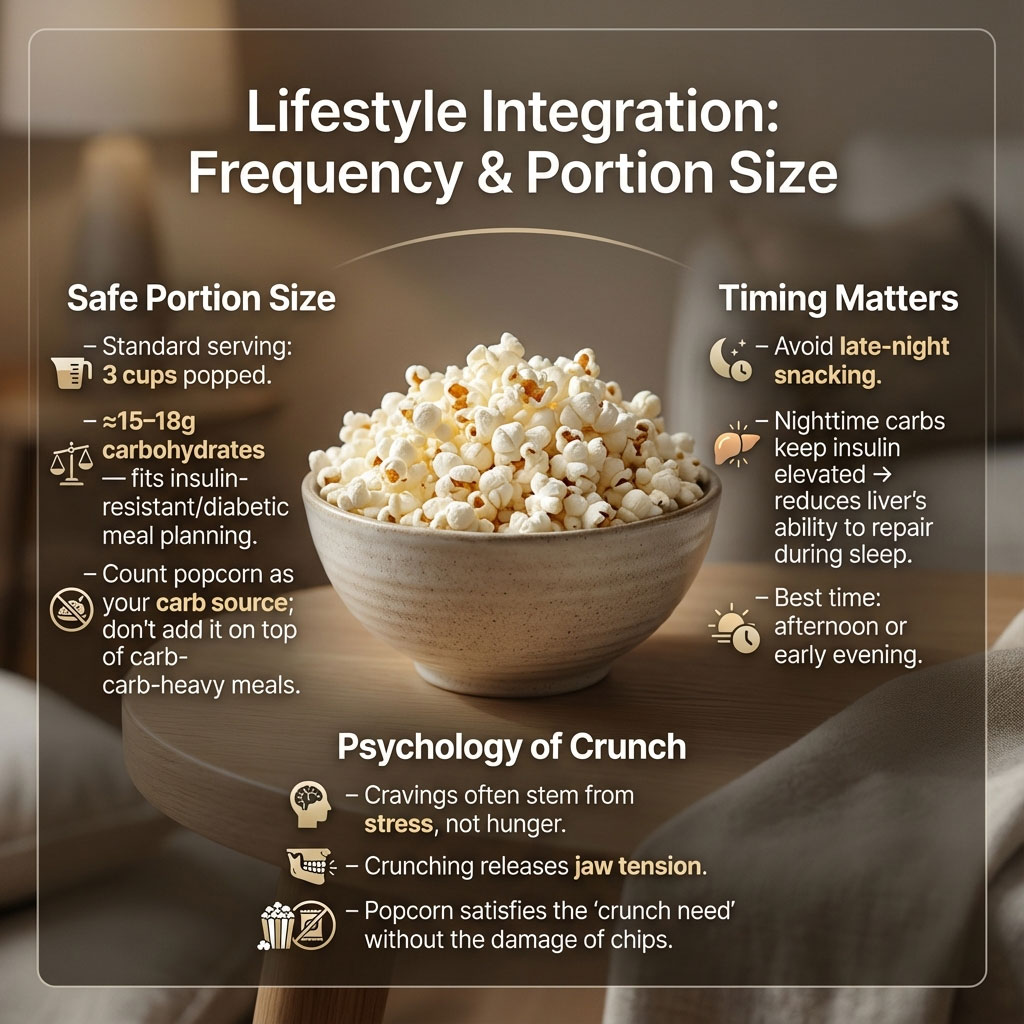
How Much Popcorn is Safe?
A safe serving size for popcorn fatty liver patients is generally 3 cups of popped corn. This provides substantial volume but keeps the carbohydrate count around 15-18 grams. This fits well within a carbohydrate-controlled diet for insulin resistance.
If you are diabetic or pre-diabetic (which is very common with MASLD), you must count popcorn as your carbohydrate serving for that snack or meal. Do not eat it on top of a full meal of rice or pasta. Treat it as your carb source.
Timing Matters
When asking is popcorn good for fatty liver, we must ask when you are eating it. Late-night snacking can be detrimental to liver health.
Eating carbohydrates right before bed can cause insulin levels to stay elevated during sleep. The liver does most of its repair and detox work at night. If it is busy processing a massive influx of glucose, it cannot perform its regenerative functions effectively. It is better to consume your popcorn NAFLD snack in the afternoon or early evening. This gives your body time to process the glucose and burn off the energy before you sleep.
The Psychology of “Crunch”
We often crave chips not because we are hungry, but because we are stressed. The act of chewing crunchy food helps release jaw tension. Popcorn satisfies this “crunch need” without the damage of potato chips. Recognizing this psychological trigger can help you stick to your diet. When you feel the need to crunch, reach for the air popper instead of the bag of Doritos.
Summary & Key Takeaways
Navigating dietary changes is difficult and emotional. But you do not have to give up everything you love. Is popcorn good for fatty liver? Yes. It is a valuable tool in your arsenal for fighting MASLD and obesity.
Here are the key takeaways to remember:
- Choose Whole Grain: Popcorn is a legitimate whole grain snack for fatty liver that provides essential fiber and polyphenols like ferulic acid.
- Avoid the Chemicals: Stay away from microwave popcorn danger. The PFAS and diacetyl risks are not worth the convenience, and the trans fats will set back your progress.
- Watch the Sodium: To prevent edema and ascites, keep salt intake low. Avoid movie theater popcorn at all costs, as the sodium levels are dangerous for liver patients.
- DIY is Best: Use an air popper or stovetop method. Season with turmeric, nutritional yeast, and healthy oils like avocado oil to maximize health benefits.
- Brand Awareness: If buying pre-made, choose LesserEvil or SkinnyPop to ensure clean ingredients and safe oils.
By making these small adjustments, you can turn a potential sodium trap into a healthy, satisfying part of your liver recovery journey.
Frequently Asked Questions (FAQs)
Is popcorn good or bad for fatty liver?
Popcorn is generally good for fatty liver if prepared correctly. It is a high-fiber whole grain that supports satiety and weight loss. However, it is bad if it is loaded with butter, sugar, or excessive salt, or prepared in chemical-laden microwave bags.
Can eating movie theater popcorn worsen nonalcoholic fatty liver disease?
Yes. Movie theater popcorn is extremely high in calories, saturated fats, and sodium. High sodium intake can lead to fluid retention (edema/ascites), while the excess calories and unhealthy fats can increase liver fat accumulation and inflammation.
Why is microwave popcorn bad for your liver?
Microwave popcorn bags are often lined with chemicals like PFOA or short-chain PFAS and contain artificial flavorings like diacetyl. These substances accumulate in the body and have been linked to liver toxicity and increased inflammation.
What is the best popcorn brand for fatty liver disease in the USA?
Brands like LesserEvil (which uses avocado or coconut oil), SkinnyPop, and Quinn Snacks (which uses chemical-free bags) are widely considered the safest commercial options for liver patients in the USA due to their clean ingredient lists.
Is air-popped popcorn good for weight loss with fatty liver?
Yes. Air-popped popcorn is a “volume food,” meaning you can eat a large amount for very few calories (roughly 30 calories per cup). This helps you feel full without overeating, which is crucial for the weight loss needed to reverse fatty liver.
Does corn cause fatty liver inflammation?
Whole corn generally does not cause inflammation and contains beneficial antioxidants. However, high-fructose corn syrup (a processed derivative of corn) is a major driver of fatty liver and inflammation and should be strictly avoided.
Can I use olive oil on popcorn for fatty liver?
Yes. Extra Virgin Olive Oil is excellent for liver health because it contains oleic acid and antioxidants. It is best to mist it onto the popcorn after popping to preserve its nutritional value and avoid burning the oil.
Is nutritional yeast safe for liver patients?
Yes. Nutritional yeast is a safe and healthy alternative to salt and cheese. It provides a savory flavor and is rich in B-vitamins, making it an ideal seasoning for low-sodium diets required for liver health.
How much popcorn can I eat per day with NAFLD?
A standard serving is about 3 cups of air-popped corn. This provides fiber and satisfaction without overloading on carbohydrates. It is best to limit it to one serving per day as part of a balanced diet.
Is kettle corn bad for fatty liver?
Yes. Kettle corn is coated in sugar to give it a sweet and salty flavor. Added sugars spike blood glucose and insulin levels, which promotes fat storage in the liver and worsens insulin resistance.
Does sodium in popcorn contribute to edema or ascites?
Yes. Sodium attracts water. For patients with advanced liver disease, the liver cannot regulate fluid balance well. Eating high-sodium popcorn causes the body to retain water, leading to swelling in the legs (edema) and abdomen (ascites).
Which is better for liver health: popcorn or nuts?
Both have benefits. Popcorn is better for “volume” and lower calories, which aids weight loss. Nuts (like walnuts) are better for healthy Omega-3 fats but are very calorie-dense. A mix of both in moderation is often the best strategy.
Medical Disclaimer
The content provided in this article, including text, graphics, images, and other materials, is for informational and educational purposes only. It is not intended to be a substitute for professional medical advice, diagnosis, or treatment.
Always seek the advice of your physician, hepatologist, registered dietitian, or other qualified health provider with any questions you may have regarding a medical condition or dietary changes. Never disregard professional medical advice or delay in seeking it because of something you have read in this article.
While popcorn can be a healthy snack for many individuals with fatty liver disease (NAFLD/MASLD), individual dietary needs vary greatly depending on the stage of liver disease (e.g., fibrosis, cirrhosis) and the presence of other conditions like diabetes or hypertension. If you have been placed on a specific sodium or fluid-restricted diet by your medical team, those instructions take precedence over general internet advice.


